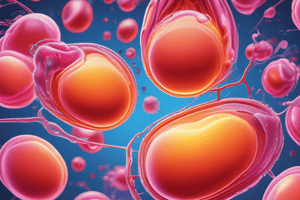Podcast
Questions and Answers
A lipid found only in foods that contain animal products is ________.
A lipid found only in foods that contain animal products is ________.
cholesterol
Excess body fat around the abdomen is associated with:
Excess body fat around the abdomen is associated with:
- elevated HDL cholesterol
- reduced chylomicrons
- elevated LDL cholesterol (correct)
- elevated triglycerides (correct)
A condition that is characterized by abnormally high blood pressure levels and is a major risk factor for cardiovascular disease is called:
A condition that is characterized by abnormally high blood pressure levels and is a major risk factor for cardiovascular disease is called:
- embolism
- myocardial infarction
- hypertension (correct)
Pair the type of fatty acid with its associated shape of the carbon chain:
Pair the type of fatty acid with its associated shape of the carbon chain:
By reading the Nutrition Facts panel, you can determine how much ________ are in most packaged foods.
By reading the Nutrition Facts panel, you can determine how much ________ are in most packaged foods.
Alcohol will contribute to ________ because it causes a person to lose fluid.
Alcohol will contribute to ________ because it causes a person to lose fluid.
________ ________ is a digestive enzyme that removes two fatty acids from each triglyceride molecule.
________ ________ is a digestive enzyme that removes two fatty acids from each triglyceride molecule.
A ________ is a fixed bunch of clots that remains in place and disrupts blood flow.
A ________ is a fixed bunch of clots that remains in place and disrupts blood flow.
Which form of unsaturated fatty acid contains a chemical structure similar to that of saturated fatty acids?
Which form of unsaturated fatty acid contains a chemical structure similar to that of saturated fatty acids?
The most common forms of cardiovascular disease in the US include (check all that apply):
The most common forms of cardiovascular disease in the US include (check all that apply):
The Dietary Guidelines for Americans recommend that adults should keep daily fat intake:
The Dietary Guidelines for Americans recommend that adults should keep daily fat intake:
Fats and cholesterol are ________, a class of nutrients.
Fats and cholesterol are ________, a class of nutrients.
Alcohol:
Alcohol:
Phospholipids contain both a hydrophobic and hydrophilic portions, which attract and repel water.
Phospholipids contain both a hydrophobic and hydrophilic portions, which attract and repel water.
Match descriptions to the correct term:
Match descriptions to the correct term:
How many Kilocalories are in one gram of fat?
How many Kilocalories are in one gram of fat?
What information can be found on a Nutrition Facts panel (check all that apply)?
What information can be found on a Nutrition Facts panel (check all that apply)?
________ is the long-term process in which plaques build up inside arterial walls.
________ is the long-term process in which plaques build up inside arterial walls.
Dietary fats often consist of different types of fatty acids.
Dietary fats often consist of different types of fatty acids.
Fats are not soluble in ________.
Fats are not soluble in ________.
Non-modifiable risk factors for CVD include (check all that apply):
Non-modifiable risk factors for CVD include (check all that apply):
What are the structural components of a triglyceride (check all that apply)?
What are the structural components of a triglyceride (check all that apply)?
Name the class of nutrients that consists of triglycerides, phospholipids, and sterols.
Name the class of nutrients that consists of triglycerides, phospholipids, and sterols.
________ is a hormone that stimulates the gallbladder to release bile and the pancreas to release digestive enzymes.
________ is a hormone that stimulates the gallbladder to release bile and the pancreas to release digestive enzymes.
Flashcards are hidden until you start studying
Study Notes
Lipids Overview
- Cholesterol is a lipid exclusive to animal products.
- Class of nutrients including fats and cholesterol is called lipids.
- Fats yield 9 kilocalories per gram.
Body Fat and Cardiovascular Health
- Excess abdominal fat correlates with elevated LDL cholesterol and triglycerides.
- Hypertension is characterized by abnormally high blood pressure and poses a major cardiovascular disease risk.
- Non-modifiable risk factors for cardiovascular disease (CVD) include family history and increasing age.
Fatty Acids
- Cis fatty acids cause carbon chains to bend; trans fatty acids keep the chain straighter.
- Dietary fats typically consist of different types of fatty acids.
Nutrition and Dietary Guidelines
- Dietary Guidelines recommend that adults keep fat intake between 20% and 35% of total calories.
- Nutrition Facts panels disclose amounts of cholesterol, total fat, trans fat, and saturated fat.
Digestive Processes and Enzymes
- Pancreatic lipase is the enzyme that removes two fatty acids from triglycerides.
- Cholecystokinin stimulates bile release from the gallbladder and digestive enzymes from the pancreas.
Cardiovascular Conditions and Terms
- A thrombus is a fixed blood clot disrupting blood flow; an embolus travels through the bloodstream after breaking free.
- Atherosclerosis refers to the long-term buildup of plaques inside arterial walls.
- Common forms of CVD in the US include stroke and coronary artery disease.
Alcohol and Hydration
- Alcohol suppresses the production of antidiuretic hormone (ADH), causing increased urine excretion and dehydration.
Triglyceride Structure
- A triglyceride is composed of three attached fatty acids and a glycerol backbone.
Phospholipids
- Phospholipids contain both hydrophobic and hydrophilic portions, making them unique in water interaction.
Studying That Suits You
Use AI to generate personalized quizzes and flashcards to suit your learning preferences.




